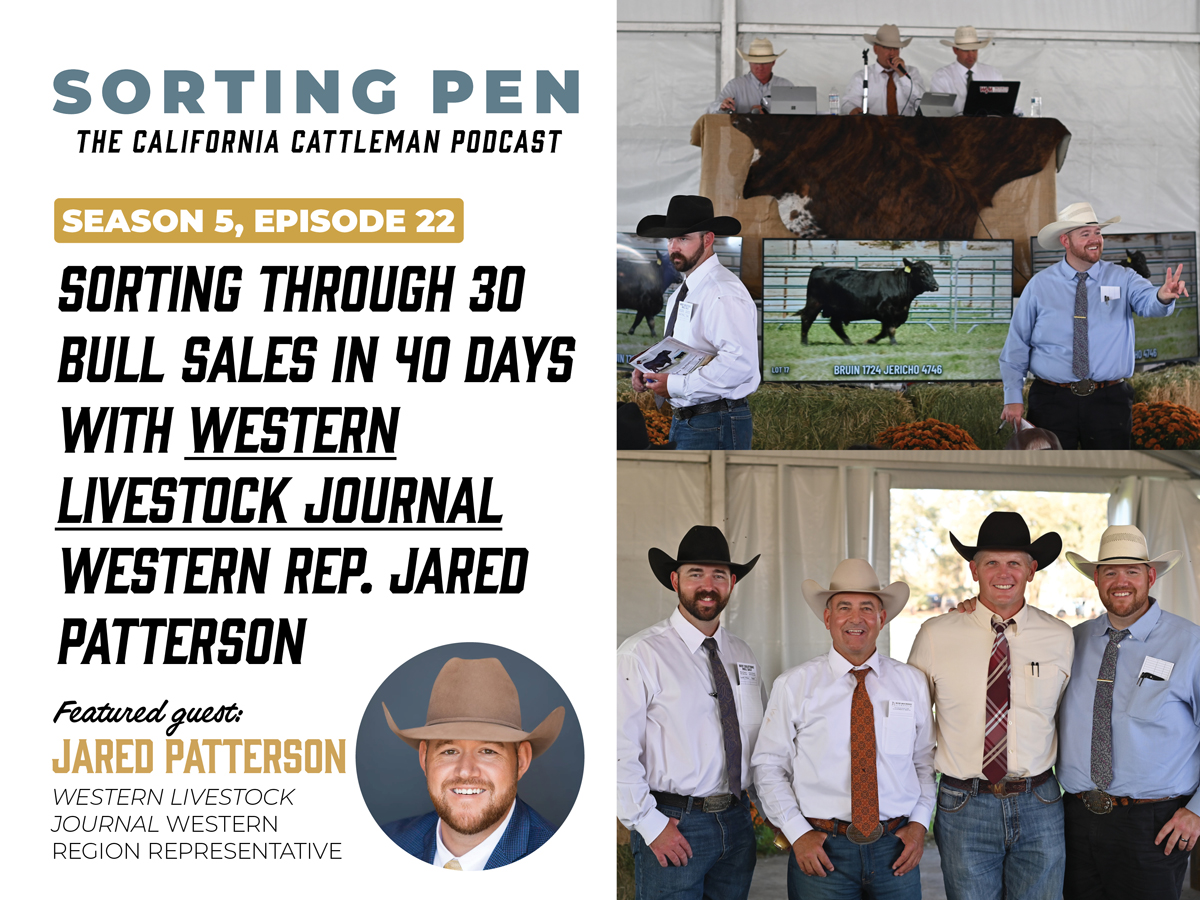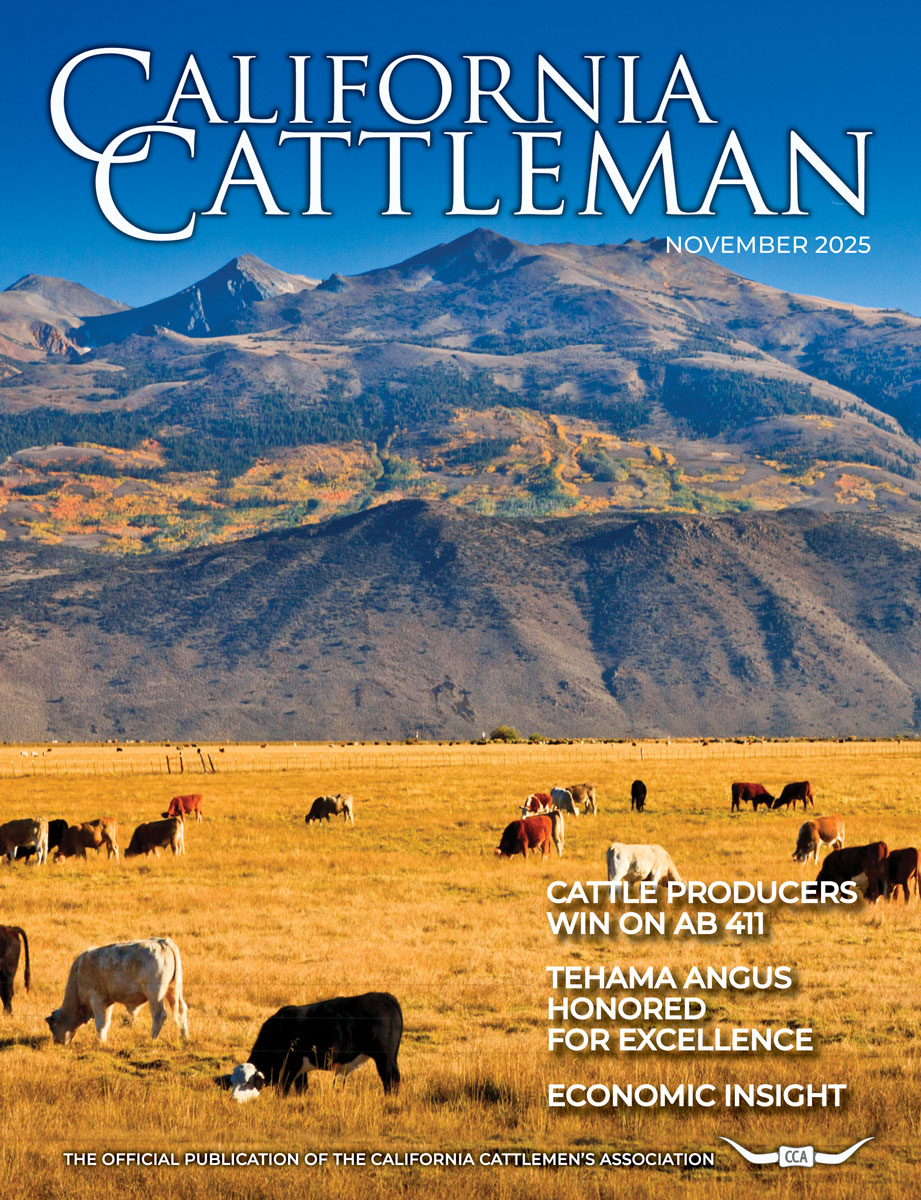
CALIFORNIA CATTLEMAN WEEKLY
Nov. 3, 2025
To read the full version each week, please subscribe below.
Your Vote Matters Tomorrow!
The California Special Election is tomorrow, Nov. 4. For rural communities, this election is crucial as Proposition 50 proposes to redraw congressional district maps. The outcome could reshape representation and influence federal policies including wildlife management, property and water rights, and many others important to California’s ranching families and producers. Your vote is vital in ensuring that rural perspectives are heard and considered. Get out and vote!
Governor Newsom Issues Executive Order to Expand Prescribed Fire Implementation
Governor Gavin Newsom announced last Wednesday that he had signed an executive order “directing state agencies to reduce red tape and expand tools to safely deploy prescribed fire.” According to the executive order, California has made significant progress in implementing prescribed fire since the catastrophic 2020 wildfire season, with the state doubling its rate of beneficial fire treatments between 2021 and 2024. Recognizing that “much more is needed,” the Governor’s latest executive order seeks to streamline the process for deploying beneficial fire on the ground.
Among other provisions, the Executive Order directs CAL FIRE “to assist local agencies and beneficial fire practitioners to complete beneficial fire projects that limit dangerous wildfire conditions,” and exempts CAL FIRE’s efforts to do so from the California Environmental Quality Act (CEQA). The Executive Order seeks to streamline deployment prescribed fire on private lands by making CAL FIRE site visits in advance of burn permit issuance discretionary rather than mandatory. The order also allows resource conservation districts and volunteer fire departments to avail themselves of the state’s Prescribed Fire Claims Fund Pilot Program and directs CAL FIRE and CalEPA to establish a process for fast-tracking beneficial fire projects even beyond the current emergency.
For more details on the beneficial fire executive order, see Governor Newsom’s press release.
CDFW Removes Beyem Seyo Pack from Sierra Valley
Late last month, the California Department of Fish and Wildlife announced that, in coordination with the U.S. Fish and Wildlife Service, it had removed the Beyem Seyo Pack of gray wolves from the Sierra Valley, including through lethal removal of four wolves. Despite what CDFW acknowledged as “extensive adaptive management deterrence efforts” by ranchers and wildlife officials in recent months, the Beyem Seyo Pack was responsible for 92 confirmed or probable livestock depredations since just March of this year. For additional details, see last week’s edition of California Cattleman Weekly.
USDA Announces “Plan to Fortify the American Beef Industry”
The U.S. Department of Agriculture has announced the release of a “Plan to Fortify the American Beef Industry,” an effort undertaken by USDA in collaboration with the Department of the Interior, the Department of Health and Human Services and the Small Business Administration to reinforce and prioritize “the American rancher’s critical role in the national security of the United States.” Several elements of the Plan would directly advance CCA policies and priorities. For example, the Plan directs the U.S. Forest Service and Bureau of Land Management to “jointly assess the viability of vacant grazing allotments and prioritize reopening them for permitted use.” For more information, see last week’s edition of California Cattleman Weekly.
USDA Releases New World Screwworm Response Playbook
The United States Department of Agriculture has announced the release of a “response playbook” which will guide the agency’s activities in the event of a New World Screwworm (NWS) detection within the United States. USDA has suggested the playbook is a “living, dynamic document,” and the agency is accepting feedback to inform their response strategy. CCA staff is carefully reviewing the documents and will share insights with USDA. As previously reported in California Cattleman Weekly, CCA recently worked with Representative David Valadao (R-CA22)’s office to secure a bipartisan Congressional request letter seeking “enhanced surveillance at the California-Mexico border to help secure our country against the threat of New World screwworm.” For more details on USDA’s NWS response strategy, see the October 20 edition of California Cattleman Weekly.
LAST CALL: CDFA Accepting Comments on Climate Resilience Strategy for Agriculture
The California Department of Food & Agriculture announced last month that it is accepting public comment on its Climate Resilience Strategy for California Agriculture (a free account signup is necessary to view the strategy document). According to CDFA’s news release, the Strategy “outlines a comprehensive vision to help California farmers, ranchers, farmworkers, and agricultural communities prepare for and adapt to current and future climate impacts.” CCA is reviewing the Strategy and will provide feedback to CDFW prior to the deadline of this Friday, November 7.
LAST CALL: RMAC Accepting Comments on Local-Regional Grazing Guidance
The Range Management Advisory Committee of the California Board of Forestry & Fire Protection has released a draft Local-Regional Grazing Guidance mandated by SB 675 (Limón, 2024) and is accepting comments in response to the draft through this Friday, November 7. For more information, visit the RMAC webpage.
Federal Government Shutdown Enters Second Month
The federal government shut down on Wednesday, October 1 after federal legislators failed to agree on a short-term continuing resolution to fund government operations. Today was the 34th full day of the shutdown; tomorrow night, this shutdown will eclipse the 2019 government shutdown to become the longest shutdown in U.S. history. For details of how the government shutdown impacts federal agencies upon which cattle producers rely, see the October 6 edition of California Cattleman Weekly. For greater details, ranchers can view USDA’s “Lapse of Funding Plan” and the Department of Interior’s “Operations in the Absence of Appropriations” plan.
Upcoming CCA Events
New World Screwworm Webinar
Nov. 19, Virtually
Join the University of California Cooperative Extension, in partnership with California Cattlemen’s Association and California Wool Growers Association for a free webinar covering the New World Screwworm life cycle and history, current situation and USDA response plans, how to prepare your ranch and insecticides for NWS prevention. This webinar will be on Wednesday, November 19th at 6:00 PM. To register, click here. The deadline to register is Nov. 18 at 1pm.
CCA & CCW Convention and California Cattle Industry Tradeshow
Dec. 3 – 5, Atlantis Casino Resort Spa, Reno, Nevada
Upcoming Industry Events
CalWATRs Workshop Happening this week!
Nov. 5, Adin Community Center
The State Water Resources Control Board is replacing its old “eWRIMS” water rights platform with the new CalWATRS platform. CalWATRS is the new online platform for all water rights administration and reporting. All water right holders and reporters will need to create new CalWATRS accounts and migrate over existing water rights records. To learn about the process and receive one-on-one assistance, come to a workshop on Nov. 5 from Noon to 4:30pm at the Adin Community Center. Laptops and Water Board IT staff will be on hand. Lunch will also be provided. To reserve your spot and see the workshop agenda, click here.
Cattle Industry Convention and NCBA Tradeshow
Feb. 3 – 5, 2026, Nashville
Get all the details on CattleCon 2026 and register at convention.ncba.org.
CCA in the News
The comeback of California’s gray wolves just took a tragic turn The National Geographic “California wildlife officials and ranchers will in all likelihood have the opportunity to put Flick’s theory to the test in the Sierra Valley, since wolves are likely to return. Another pack dens in an area north of the valley, and young wolves regularly leave their natal packs in search of mates and unoccupied territories to make their own. Local rancher Rick Roberti, who also heads the California Cattlemen’s Association, says he spotted a wolf he didn’t recognize near his property in the last few days, possibly dispersing from another pack.” To continue reading, click here.
Industry News
Guest Essay: The Reality of Living With Wolves, Bears and Mountain Lions The New York Times “Fortunately, livestock producers and wildlife managers around the West have been experimenting with strategies to minimize the need to remove predators. These efforts include removing livestock carcasses to reduce predators’ attraction to ranches, increasing human presence to scare them away (known as ‘range riding’), deploying deterrents like flashing lights or loud music, and more. Some ranchers have also adjusted the timing or location of calving and grazing to limit a herd’s exposure to predators. These approaches also benefit from compensation for livestock deaths, and assurances that if all else fails, lethal tools are on the table.” To continue reading, click here.
NCBA Reaction To Secretary Rollins’ Recently Released Beef Industry Plan Southeast Ag Net “With U.S. Secretary of Agriculture Brooke Rollins unveiling her new plan to strengthen the American beef industry, the policy has quickly drawn reaction from across the cattle sector. The plan, which focuses on protecting ranching operations, expanding processing capacity, and boosting domestic demand, was welcomed by many in the cattle community — including the National Cattlemen’s Beef Association (NCBA).” To continue reading, click here.
New Episode of Sorting Pen: The California Cattleman Podcast
As California’s fall bull sale run winds down, Western Livestock Journal Western Region Representative Jared Patterson joins us to recap how this year’s sales went the past few months. We chat about this year’s outstanding sale averages, what makes California seedstock producers shine, EPDs, and more. Jared also shares some favorite moments from the road and the best advice for anyone getting ready to buy their next bull.
Click here to listen or stream it wherever you listen to podcasts.



